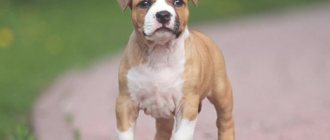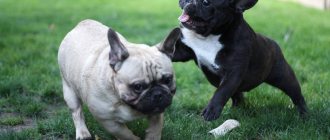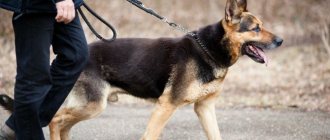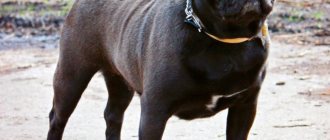- Dog breeds
The Dobermann is a large German dog breed with an athletic build. They were bred to serve as bodyguards, serve in the army and police, and in the right hands become companion dogs.
- Country of origin : Germany
- Height at withers : male: 68-72 cm; female: 63-68 cm
- Weight : male: 40-45 kg; female: 32-35 kg
- Lifespan : 12-15 years
- Use : Watchman, Security Guard, Companion Dog
- Other names : Doberman Pinscher, Thuringian Pinscher
History of the breed
Dobermanns were developed in Germany in 1880 and named after their founder, Friedrich Karlk L. Dobermann. The history of the origin of the breed is very interesting. Friedrich Karlk L. Dobermann worked as a tax collector and needed an assistant and protector in such a responsible position. To do this, he decided to breed a new breed. Participating in the crossing were:
- german pinscher
- Rottweiler
- German Shepherd
- Manchester Terrier
The breed was recognized in the 20th century. Initially they were called the Thuringian Pinscher, then the Doberman Pinscher, and only in the middle of the 20th century acquired the final name “Doberman”.
Think before you get a Doberman Pinscher!
Don't forget that when you buy a dog, you take responsibility. The phrase “We are responsible for those we have tamed” is very popular here; unfortunately, sometimes people forget about this. Be prepared for various difficulties that you will encounter when training a Doberman and when caring for him. A dog is the same child, it also experiences different feelings that we experience.
The most important thing is to consciously approach the choice of your breed; you need to listen to your heart and really understand whether you can raise such a dog. Such dogs require more activity than small and medium breeds. So, if you are an athlete or just need a little sport, then you can safely buy a Doberman Pinscher. It contains the desire for activity, love, affection, and kindness. He will be your best companion.
Doberman character
- Vigorous
- Active
- Mobile
- Temperamental
- Distrustful
- Restrained
- Decisive
- Devoted
- Confident
- Vigilant
- Smart
- Obedient
Dobermans choose an owner with a strong character and strong nerves. If the owner shows weakness, then his status in the eyes of the dog will drop to zero and it will be an aggressive dog.
Doberman: features of the breed
- Early socialization . It is necessary to take your puppy to crowded places, parks and dog parks from a very early age.
- To a spacious apartment or private house . The dog is very active, agile and energetic.
- Active walks . Regardless of where he lives in an apartment or in a private house, long walks and physical activity are necessary.
- A training course is required . To prevent the Doberman from becoming socially dangerous to others and the owner himself, it is necessary to undergo a training course.
- For experienced owners . Dobermans have a very strong and firm character and require experienced hands. Any disorganization infuriates the dog.
- Not demanding in care.
- One owner dog . All family members are treated with tolerance.
- Excellent security guards . They protect the territory and owner entrusted to them to the last.
- With untimely and improper training, the Doberman becomes aggressive and socially dangerous.
Doberman Paw Care
Doberman paws require special care. Paw pads are one of the weakest and most vulnerable places. Therefore, they are subject to daily inspection to detect cuts, cracks and thorns and thorns stuck in them, thereby preventing the formation of blisters and inflammations. In addition, traces of tar, fuel oil, or similar substances may remain on the paws, which will lead to poisoning if the dog licks them off.
Contrary to the belief of many dog breeders that the dog erases its own claws, this is not so! Nail trimming is necessary.
The Doberman needs nail trimming approximately once a month. Not only can excessively long nails spoil the structure of the paw itself, making it excessively loose and flat, but it can also lead to inflammation of the nail fold! To trim claws, you must use a special nail clipper with a limiter.
It must be remembered that the claw consists of two parts - this is the “living part”, which contains blood vessels with nerve endings and the cornea.
The main thing is to correctly set the limiter of the nail clipper and remove only the keratinized tissue. If you accidentally snag a vessel, sprinkle potassium permanganate on paper or a dry cloth and apply it to the nail. The blood will stop. After calming the dog, continue trimming - the dog should not develop associations between trimming nails and pain.
Health
Dobermans are in good health. Predisposed to the following diseases:
- dysplasia of the elbow and hip joints
- heart rhythm disturbance and dilatation
- cardiomyopathy
- Wobbler syndrome
- osteopathy
- epilepsy
- hypothyroidism
- coagulopathies
- oncological diseases
- gastric volvulus
Preventative measures to protect your Doberman puppy
- To keep your Doberman puppy completely safe, you first need to minimize his contact with unfamiliar dogs, especially homeless ones. Therefore, you should not let your dog off the leash, as in this case it will become impossible to control its behavior and communication with other dogs. Since a dog can easily become infected with distemper from simply touching the nose of a sick animal. This disease can be transmitted to a dog through sniffing. Your dog can become infected with trichophytosis from contact with the lichen-affected fur of a sick dog. Naturally, it is impossible to completely exclude a dog’s communication with other dogs, since it must be socialized. Therefore, try to find friends with dog lovers who look after their animals. By adhering to this rule, you can eliminate the risk of pathogen transmission by 80%.
- You should walk your dog in places where there are no landfills. Since garbage very often attracts rodents, which in turn are very often carriers of various infections. Gray rats are especially dangerous because they carry such a serious disease as leptospirosis.
- You should not allow your dog to sniff other people's feces, as they are a source of worms.
- Monitor your Doberman's health. Pay attention to even the most minor changes in his behavior. For example, your dog may appear lethargic, lose his appetite, or have a dry nose. Or you may notice that the dog begins to shed, and this has nothing to do with seasonal shedding. If hair loss becomes excessive, this is the first symptom indicating health problems in your pet. And only you can help him. Therefore, it is important to take the dog to the veterinary clinic in time, where the disease can be overcome for sure. In no case should you ignore the symptoms, since advanced infections are much more difficult to treat, and sometimes even impossible. If you start treating your dog, the disease can lead to his death or he will develop serious complications that will affect his hearing, vision, limbs and much more.
Description and photo
- Origin : Germany.
- Group : Working. Used as a service, search or guard dog.
- Recognized by : ACR, AKC, ANKC, APRI, CKC, FCI, NKC, NZKC, UKC.
- Lifespan : 8–12 years.
- Litter : 3–8 puppies.
- Coat color : Black, brown, less often - brown with a yellowish tint or black with a blue tint.
- Coat length : Short.
- Shedding : Short.
- Dimensions : “At the withers” males grow to 68–72 cm, females are slightly inferior to them (63–68 cm).
- Weight : 40–45 kg (males), 30–35 kg (females).
This is a fairly large animal with well-developed muscles.
Looking at the photographs, you can see that the body is perfectly proportioned, and the main lines of the body almost outline a square. Thanks to this, Dobermans run very fast. Important! Ear cropping is performed at 7–8 weeks of life. At the same time, there is no urgent need for this for a domestic dog, and in many countries the procedure is completely prohibited.
The dog is also distinguished by a proud, upright posture, which seems to emphasize his confidence in his abilities. Let’s add here the “signature” erect ears, and it will become clear why the Doberman service dog breed does not lose its popularity.
The breed standard also provides for the following features:
- A narrow head, the two upper lines of which run parallel and are separated by a clear transition from the forehead to the muzzle. The forehead line is lowered to the cheekbones with a slight transition. The head is clearly separated from the nape.
- Wide muzzle with tightly closed lips. 42 teeth have a scissor bite. The skin is stretched tightly, and the flat muscles are emphatically dry, almost sculpted.
- Dark eyes of medium size. Dogs with brown or bluish coats may have a lighter tint.
- The nose is the same tone as the overall color.
- The neck is dry and muscular, set high and in harmony with the proportions of the body and head.
- Well developed long withers (especially in males).
- A short, strong back, turning into a powerful loin and sloping croup. The ribs are lowered to approximately the ulnar line. From the edge of the sternum, the abdomen is expressively tucked in, and a characteristic undercut is visible from the side.
- The forelimbs stand at right angles. Plumb forearms are straight, elbows tucked to the chest. The round paws are brought together into a ball.
- The hind limbs are distinguished by well-developed muscles and a large angle of motion of the knee joint. Toes on paws are not dewclaws.
- Dobermans have free movements; they have a sweeping and light step. Both pairs of legs touch the ground at the same time, the front ones are carried far forward, while the rear ones provide the necessary force.
Previously, the breed was called “Doberman Pinscher”, but in the modern breed standard it is simply listed as “Doberman”.
Training and education
A training course is required ! Dobermans are highly trainable. They are very capable and willing to please their owner. A controlled dog is something to strive for.
Submitting a dog doesn't always work. The principle of complete submission of the Doberman to the owner is an outdated method. This theory was formulated based on observations of packs of wild wolves, but they were kept in captivity and, of course, experienced stress. The stress condition forced wolves to show aggression towards each other, but in the wild they do not show aggression to each other - they live together and interact with each other. You need to perceive yourself as the more experienced and mature member of the pack, who is responsible for guiding the new member (Doberman puppy) and teaching him good behavior, as well as correcting him if necessary. It is important to remember that Doberman puppies learn a lot on their own. They are very inquisitive, love to explore new territories and, of course, experiment. Puppies tend to repeat actions they enjoy (like playing with a toy). They do not repeat actions that cause them pain (for example, destroying a nest and getting bitten). If your Doberman puppy misbehaves, ignore him and praise him when he does the right thing. Reward your puppy for following commands and good behavior. Do not neglect these tips. After all, constantly hearing “you can’t” all day long is unbearable. This is a small child who wants to know everything and get his portion of treats as a reward for not eating your favorite rug, going to the toilet outside, bringing you a ball, and so on.
Set rules and monitor their implementation
It is worth enrolling your Doberman puppy in obedience training classes. These classes will allow you to understand exactly what actions will allow you to control your dog’s behavior. You will be able to spend more time with your puppy, establish contact and socialize around other dogs.
Adviсe
- Training a Doberman puppy should be done with the help of positive motivation; watch carefully special films about this technique. The Canine Translator film series from National Geographic is suitable.
- If you need to leave your puppy at home alone for 2 hours or more, then ask someone to come to him.
- Be sure to make an appointment with your Doberman puppy to see the vet as soon as possible. The doctor will carefully examine him and give him vaccinations that will protect him from dangerous diseases.
Caring for Doberman ears
Dobermans' ears should be examined once or twice a week. To remove dirt and earwax, use a dry and clean cotton cloth or cotton swabs. In case of severe contamination, it is necessary to use special oil-based cleaners or therapeutic and prophylactic drops (Otoferanol, Bars, etc.). The inner surface of the ear must be wiped with a dry cloth (bandage), and then carefully remove accumulations of dirt and wax from the ear canal with a cotton swab, inserting the stick only within “visual range” to avoid damage to the eardrum.
Attitude towards children and pets
She is quite tolerant of all family members if you raise her properly. In addition, all family members should interact with the dog, walk and train.
They can get along with other animals, but only if the owner takes the situation into his own hands. In skillful hands, the dog will be able to get along with all family members.
If you decide to get a dog, especially a puppy, then get ready for the following: you will often have to clean up little mistakes after the puppy; investments will be required in annual vaccinations, feeding, toys, ammunition, etc.; any animal requires attention and communication, so if you don’t have time, then there will be no mutual understanding with your Doberman puppy. Big changes are coming in your life. If you can handle this, you will find a loyal friend for life.
Care and maintenance
The process of caring for Doberman dogs is quite simple and does not require special procedures: at the age of five days, dogs of this breed have their tail docked, and three months later, their ears are docked.
Until six months, a Doberman must have a standard list of vaccinations. The period for repeat vaccinations is one year.
There is no need for frequent brushing of these dogs . A weekly wipe with a damp towel and then brushing with a stiff-bristled brush is sufficient.
It is recommended to bathe a Doberman once every six months, as frequent bathing can harm your pet by weakening its immune system.
After a walk in the fresh air in the rain, it is quite enough to wash your pet’s paws.
The Doberman's eyes and ears require systematic monitoring. They must be cleaned periodically using a cotton swab slightly moistened with clean water.
You should also pay a little attention to the length of the claws: if they are not sharpened enough, you need to trim them yourself.
The owner must take care of the cleanliness and hygiene of the pet’s toys and food utensils. In addition, quite often you need to clean your dog’s bedding from hair and dust.
The duration of walks in the fresh air should be a couple of hours a day (the exception is the cold season, if your pet is not wearing warm overalls). The walk should be meaningful and interesting for the pet.











